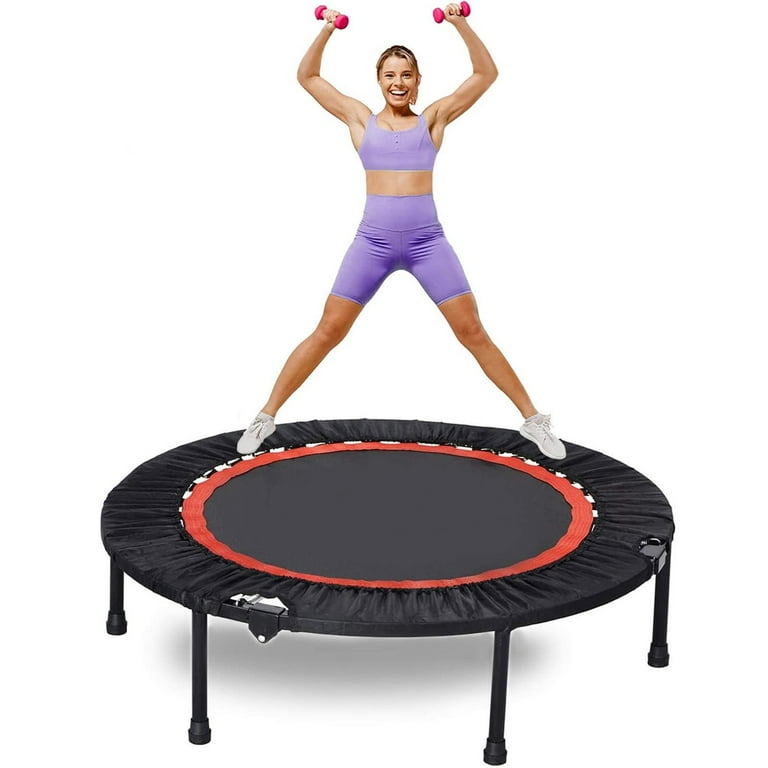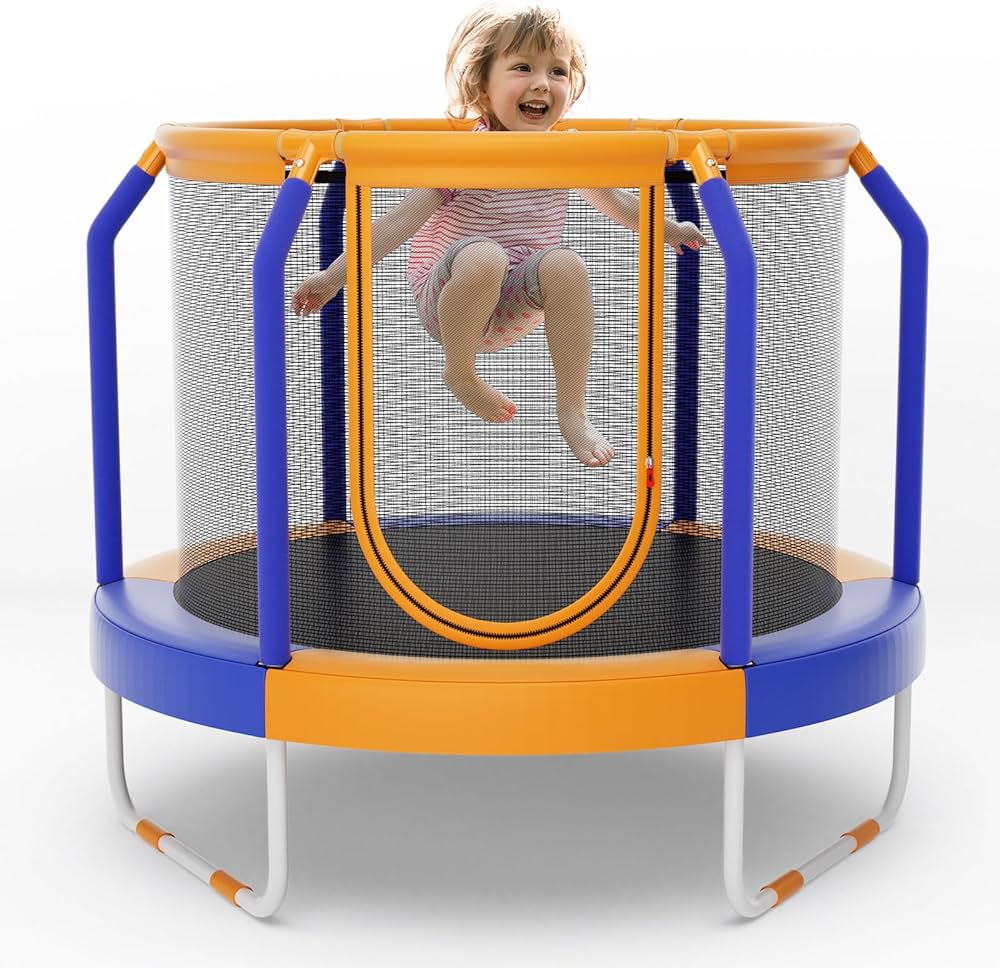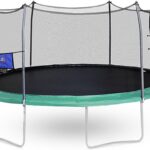Indoor trampolines typically require a clear ceiling height of at least 8-10 feet. Outdoor trampolines need an open area that is free from overhead hazards.
Trampolining has soared in popularity, becoming a favorite for both fitness enthusiasts and families seeking backyard fun. An appropriate space for a trampoline ensures safety and maximizes enjoyment. For indoor setups, consider room size and ceiling clearance to prevent accidents.
Outdoor trampolines should be placed on level ground away from trees, fences, and other structures. Choosing the right space can enhance your trampolining experience, whether you’re perfecting gymnastic jumps or giving the kids a fun way to exercise. Manage space wisely to keep jumpers safe and smiles wide as they bounce away to their hearts’ content.

Credit: www.walmart.com
Jumping Safely: Space Requirements For Trampolines
An indoor or outdoor trampoline promises endless fun. Proper space is critical for safety. This guide outlines space needed for trampolines. Read on to ensure a secure environment for every leap and bounce.
Minimum Area Recommendations
When setting up a trampoline, the size of the trampoline isn’t the only consideration. Extra room around the trampoline is a must. This ensures jumpers don’t bump into obstacles. Below are the minimum space guidelines to follow:
- For indoor trampolines: Allow at least 6 feet clearance overhead and 2 feet around each side.
- For outdoor trampolines: Provide a clear area of at least 24 feet vertically and 6 feet horizontally around the trampoline.
These guidelines help prevent accidents. Always check the trampoline’s manual for specific requirements.
Understanding Clearance Zones
Clearance zones are areas around a trampoline that must be free of obstacles. Clear zones are essential for safety.
Here’s what to consider:
- Horizontal clearance: Space on all sides of the trampoline.
- Vertical clearance: Space above the trampoline, including trees or ceilings.
Ensure these zones are free of walls, furniture, and hazards. Below is a simple table showing clearance requirements.
| Type of Trampoline | Horizontal Clearance | Vertical Clearance |
|---|---|---|
| Indoor | 2 feet | 6 feet |
| Outdoor | 6 feet | 24 feet |
By adhering to these space requirements, jumping on a trampoline remains fun and safe for everyone.

Credit: www.amazon.com
Indoor Trampoline Considerations
Thinking about adding a trampoline to your indoor play area? Don’t just jump in! Indoor trampolines need special attention. Let’s explore what we need to consider first.
Ceiling Height For Indoor Bouncing
Safety comes first! Check your ceiling height before setting up an indoor trampoline. Here’s the deal:
Trampolines add spring to your jump. Kids need enough space to bounce without risk. Aim for a ceiling at least 8-10 feet above the trampoline. Measure carefully to prevent head bumps!
Flooring And Padding Needs
Falls happen, even indoors. Trampolines must have proper padding around them. The type of floor matters too.
- Use thick pads on the floor. They cushion falls.
- Place the trampoline on a non-slip surface.
- Ensure surrounding space is clear of hard objects.
Add anti-skid rubber mats under the trampoline. Accidents reduce this way. Enjoy safe, indoor fun!
Outdoor Trampoline Placement
Finding the right spot for your outdoor trampoline ensures safety and fun. The placement is crucial. It affects how often the trampoline gets used and its lifespan. Let’s jump into what makes the perfect location for your bouncing haven.
Importance Of Level Ground
Setting up on level ground is a must. Why? A tilted trampoline is risky. It can cause falls. Or worse, the trampoline may tip over. Make sure the spot you pick is flat. Use a level if you have to. This ensures everyone stays safe while jumping.
What if your yard isn’t flat? No problem. You can level the ground. Use sand or soil to fill in low spots. Check the surface again. Now, you’re good to go!
Sunlight And Weather Exposure
Where your trampoline sits also means thinking about the sun and weather. Direct sunlight can fade the trampoline. It can make some parts weaken quicker. Pick a spot with some shade if possible. This helps the trampoline stay in top shape for longer.
Consider the weather. Trampolines face rain, wind, and even snow. Find an open area, but not too exposed. This helps reduce damage from strong weather. Use a cover for extra protection. This keeps the trampoline ready for use, no matter the season.
Remember these points for the best outdoor trampoline experience:
- Choose a level spot.
- Look for areas with some shade.
- Protect it against harsh weather.
Safety Features And Add-ons
Trampolines bring joy and exercise into our lives, but safety is key. Protecting jumpers from injury is essential. The right safety features and add-ons can make a world of difference. Knowing which ones are vital requires understanding their size and placement implications.
Enclosure Nets And Their Space Impact
Enclosure nets are a must-have for any trampoline, indoor or outdoor. They prevent falls and ensure a secure boundary. But how do they impact the space needed?
- Height: Check the height of the enclosure. There should be ample clearance above and around.
- Diameter: Nets should sit a few inches from the edge. This adds slightly to the overall diameter needed.
- Installation Area: Ensure space around the trampoline for the net’s support poles and anchors.
Padding And Safety Mats: Size And Placement
Padding and safety mats are crucial to cushion jumpers from springs and frames.
| Feature | Space Requirement |
|---|---|
| Spring Padding | Must cover all springs snugly, adding a few inches to each side of the trampoline. |
| Frame Cushioning | Wraps around the frame to soften edges, yet doesn’t increase needed space. |
| Mats Around Trampoline | Positioned outside, they should extend several feet to create a safe perimeter. |
Choose thick, durable materials for longevity. Always ensure these features remain secure for safety and space efficiency.
Legal And Insurance Aspects
Before you leap into the world of trampolining, understanding the legal and insurance aspects is crucial. These ensure your family stays safe and you’re covered in any scenario. Let’s jump right into local regulations and insurance policies that every trampoline owner should know.
Local Regulations On Trampoline Installation
Trampoline installation isn’t just about space; it’s about compliance too. Here’s what you need to consider:
- Check zoning laws: Your local government may have specific rules about trampoline placement.
- Property lines matter: Position your trampoline within your property boundaries to avoid disputes.
Distance from structures: Maintain a safe distance from fences, trees, and buildings.
Always consult with your local council to get the latest, accurate guidelines for your area.
Insurance Policy Considerations
While trampolines promise endless fun, they also come with risk. Protect yourself with the right insurance policy:
- Homeowners insurance: Some policies may not cover trampoline-related claims. Verify with your provider.
Increase liability coverage: Consider a higher liability limit to safeguard against potential accidents.- Umbrella policies: These can provide extra protection above your standard liability coverage.
Remember, insurers might require safety measures like enclosures or nets. Always disclose your trampoline to your insurer to avoid issues in case of an accident.
Maximizing Space And Enjoyment
Maximizing Space and Enjoyment with an indoor or outdoor trampoline brings energy and excitement to any home environment. Finding the right balance between safety, aesthetics, and fun can be a challenge. Let’s explore innovative ways to integrate trampolines seamlessly into your living space, ensuring every bounce is a joy.
Incorporating Trampolines Into Landscaping
Transform your garden into a fun zone! Plan around the trampoline, using it as a central feature. Surround it with soft grass or rubber mulch to create a safe landing zone. Add some greenery by planting shrubs or flowers that add color and life without crowding the space. Consider a sunken trampoline for a sleek look and improved accessibility.
- Choose easy-to-maintain plants that won’t encroach on the jumping area.
- Install garden lights for night-time bouncing adventures.
- Sunken design not only looks great but also increases safety.
Creative Ideas For Small Spaces
Short on space? No problem! Utilize vertical designs with lofted or fold-away trampolines that store easily. Take advantage of corners or unused stretches along the side of your home. Prioritize a trampoline with a strong frame and high-quality mat to ensure durability and longevity.
| Small Space Solution | Benefits |
|---|---|
| Corner trampolines | Maximizes unused areas |
| Vertical, wall-mounted trampolines | Saves floor space |
| Foldable trampolines | Easy to pack and store |
Consider trampolines with adjustable legs to fit uneven surfaces. Add protective netting around the trampoline, which offers safety without compromising fun. Opt for colors and designs that blend with your space, maintaining aesthetic appeal.

Credit: www.walmart.com
Frequently Asked Questions On Space For An Indoor And Outdoor Trampoline
What Is The Ideal Space For Indoor Trampolines?
The ideal space for an indoor trampoline should accommodate the trampoline’s size with an additional clearance of at least 6 feet around the perimeter. High ceilings are necessary, generally 10-12 feet above the trampoline to ensure safe jumping.
How Much Backyard Space Is Needed For Outdoor Trampolines?
For outdoor trampolines, you should aim for a level surface with a clear space that exceeds the diameter of the trampoline by at least 6-8 feet on all sides. Overhead clearance should be free of branches and wires.
Does Trampoline Size Affect Space Requirements?
Yes, trampoline size directly impacts space requirements. Larger trampolines need more room for both installation and safe usage, adding to the perimeter clearance and overhead space. Consider the size carefully in relation to your available space.
What Safety Precautions Need Space Consideration?
Safety precautions include adequate padding around the trampoline, safety net installation, and ample clearance from walls, fences, and furniture. Space for safety features should not be compromised, as they are essential for preventing accidents.
Conclusion
Selecting the right space for your trampoline, be it indoor or outdoor, matters immensely. Adequate clearance and safety parameters ensure a risk-free experience. Remember, thoughtful placement contributes to both enjoyment and longevity of your trampoline. Jump into fun—and safety—right from your chosen spot!


